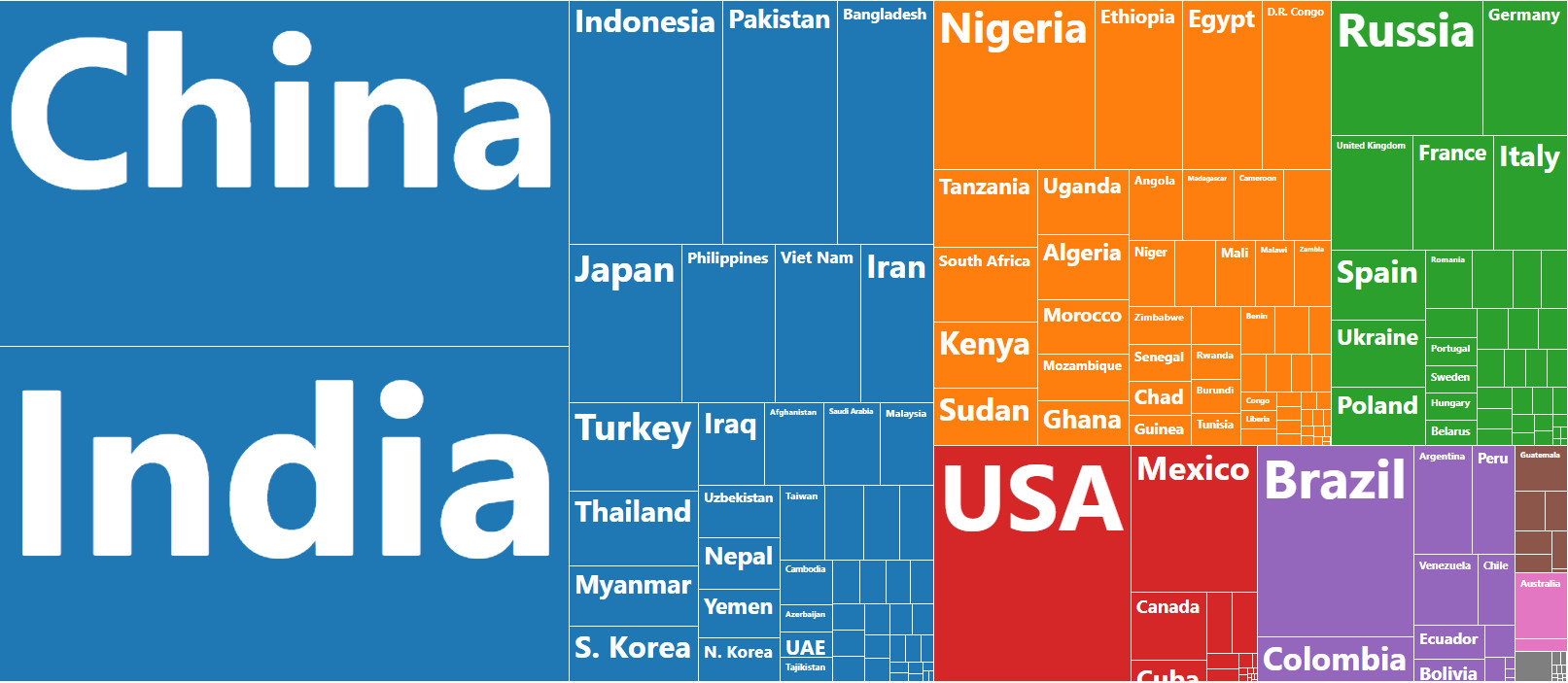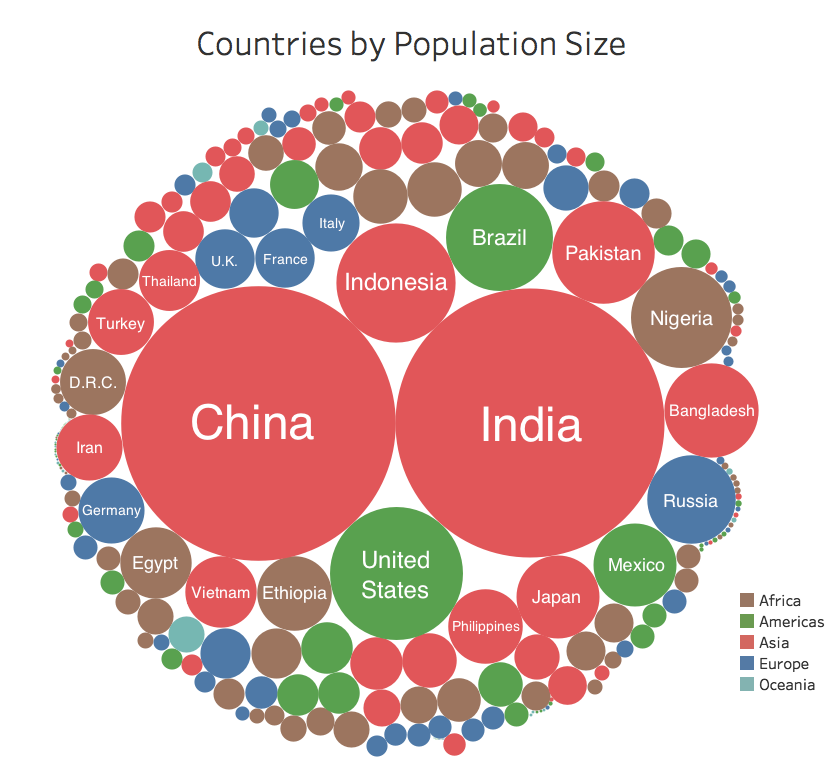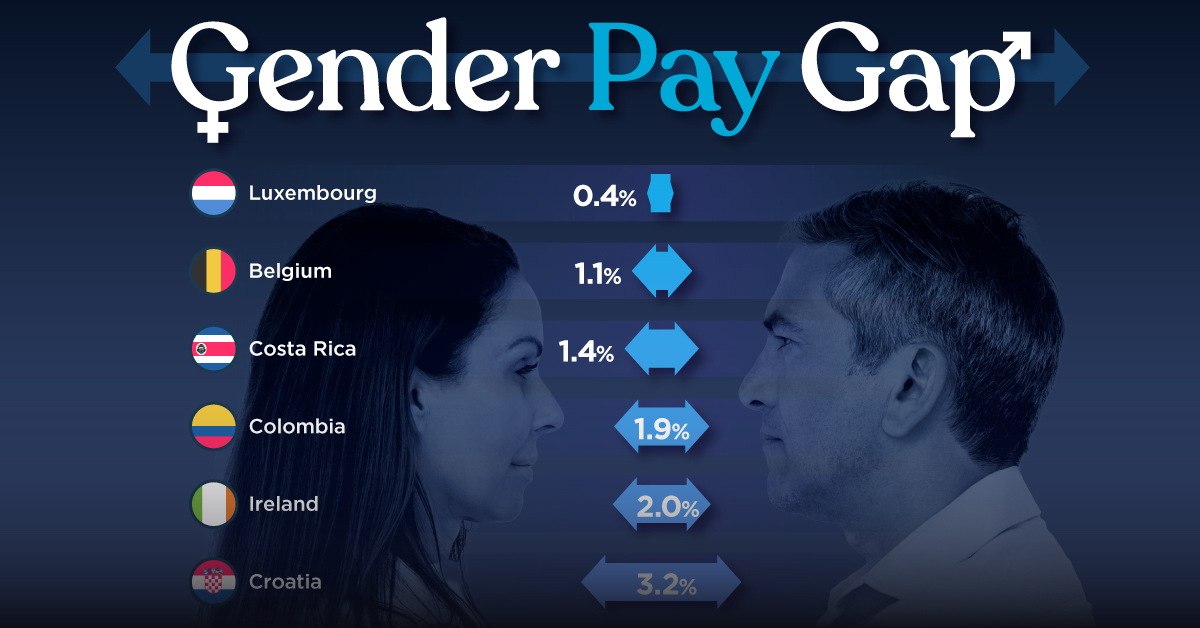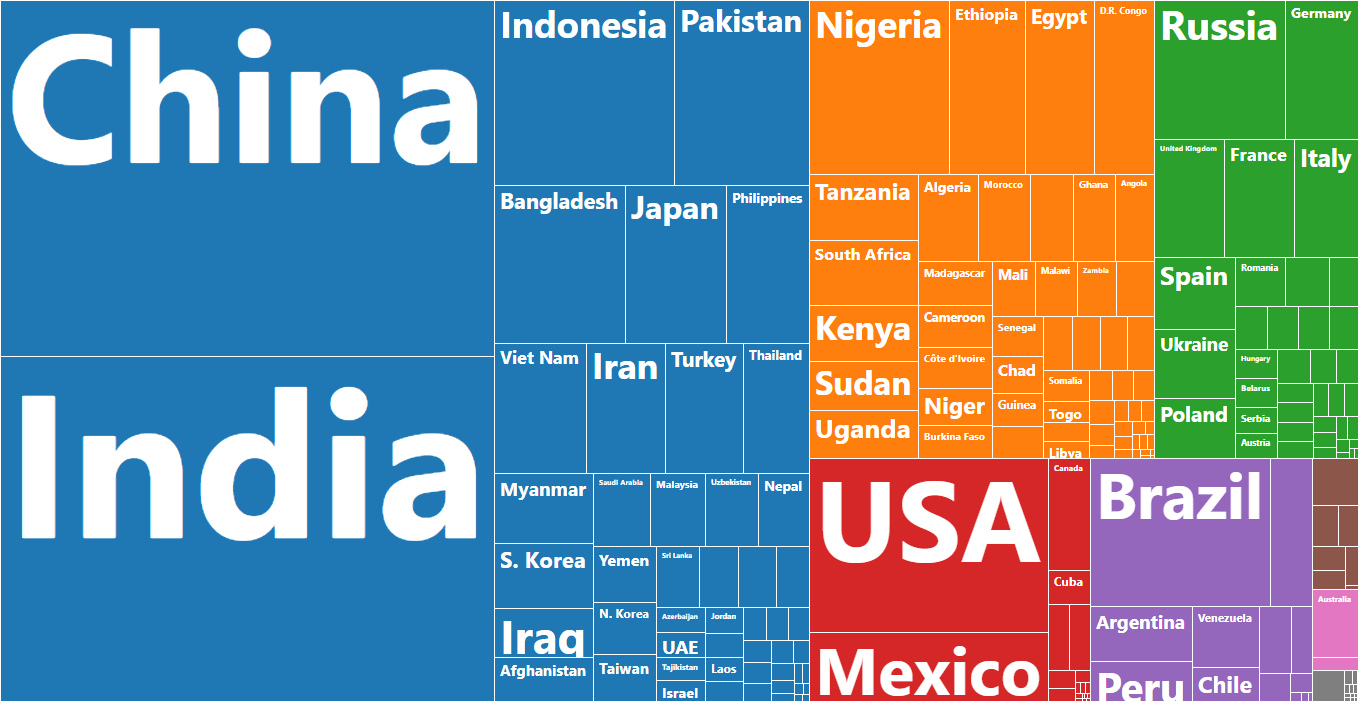Demographics
The World’s 7.5 Billion People, in One Chart

Which countries do people live in, globally?
It’s a very simple question, but it’s also hard to get an accurate sense of the answer by browsing through a lengthy table of country-level population data.
That’s because there are close to 200 countries spread around the globe, with populations ranging from near 1.4 billion (China or India) to countries a mere 0.001% of that size. How is it possible to do the mental math in interpreting such a wide range of data points simultaneously?
Visualizing the World’s Population
Today’s data visualization comes to us from PopulationPyramid.net, a fantastic resource for data on global population numbers.
It allows us to see the location of the world’s 7.5 billion people by resizing countries based on their populations and then coloring and organizing them by region.
This simple application of data visualization makes it more intuitive to comprehend where people live around the globe, as well as how different countries compare in size.
Regional Populations
The first thing you might notice on the graphic is the relative size of regions, with Asia taking up a whopping 60% of the visual space.
Here are those numbers by region broken down further:
| Rank | Region | Share of Global Population (%) | Population |
|---|---|---|---|
| #1 | Asia | 60% | 4.5 billion |
| #2 | Africa | 16% | 1.2 billion |
| #3 | Europe | 10% | 729 million |
| #4 | North America | 7% | 534 million |
| #5 | South America | 6% | 424 million |
| #6 | Central America | 1% | 47 million |
| #7 | Oceania | 1% | 42 million |
When you look at it this way, you can really see how the math breaks down.
About 75% of people reside in Asia or Africa. Meanwhile, the regions of Europe, North America, South America, and Oceania just total together to 25% of the mix.
The 10 Most Populous Countries
There are some countries that are clear standouts on the data visualization.
For example, China and India combine to 2.7 billion people, together accounting for 36% of the total global population.
Those heavyweights aside, there are other notable countries that take up significant amounts of real estate on the visualization as well:
| Rank | Country | Population (2017) | % of global total |
|---|---|---|---|
| #1 | 🇨🇳 China | 1,388,232,693 | 18.5% |
| #2 | 🇮🇳 India | 1,342,512,706 | 17.9% |
| #3 | 🇺🇸 United States | 326,474,013 | 4.3% |
| #4 | 🇮🇩 Indonesia | 263,510,146 | 3.5% |
| #5 | 🇧🇷 Brazil | 211,243,220 | 2.8% |
| #6 | 🇵🇰 Pakistan | 196,744,376 | 2.6% |
| #7 | 🇳🇬 Nigeria | 191,835,936 | 2.6% |
| #8 | 🇧🇩 Bangladesh | 164,827,718 | 2.2% |
| #9 | 🇷🇺 Russia | 143,375,006 | 1.9% |
| #10 | 🇲🇽 Mexico | 130,222,815 | 1.7% |
| Top 10 Total | 4,358,978,629 | 58.0% |
The United States, Indonesia, Brazil, and Pakistan rank between #3 and #6, and have about a billion people between them.
Nigeria, which is #7 on the list, has the world’s fastest growing megacity within its borders. Further, Bangladesh is also a noteworthy entry since it is one of the densest populations globally, with 1,138.9 people per square kilometer of land.
A Final Look at Global Population
This isn’t the first time we’ve shown you a data visualization that organizes the global population – here’s one we previously published that shows each country in a bubble chart:

While this uses slightly older data, it is still interesting to see how data visualization can help us understand a complex and wide-ranging set of data that is relevant to everyday life.
Demographics
The Smallest Gender Wage Gaps in OECD Countries
Which OECD countries have the smallest gender wage gaps? We look at the 10 countries with gaps lower than the average.

The Smallest Gender Pay Gaps in OECD Countries
This was originally posted on our Voronoi app. Download the app for free on iOS or Android and discover incredible data-driven charts from a variety of trusted sources.
Among the 38 member countries in the Organization for Economic Cooperation and Development (OECD), several have made significant strides in addressing income inequality between men and women.
In this graphic we’ve ranked the OECD countries with the 10 smallest gender pay gaps, using the latest data from the OECD for 2022.
The gender pay gap is calculated as the difference between median full-time earnings for men and women divided by the median full-time earnings of men.
Which Countries Have the Smallest Gender Pay Gaps?
Luxembourg’s gender pay gap is the lowest among OECD members at only 0.4%—well below the OECD average of 11.6%.
| Rank | Country | Percentage Difference in Men's & Women's Full-time Earnings |
|---|---|---|
| 1 | 🇱🇺 Luxembourg | 0.4% |
| 2 | 🇧🇪 Belgium | 1.1% |
| 3 | 🇨🇷 Costa Rica | 1.4% |
| 4 | 🇨🇴 Colombia | 1.9% |
| 5 | 🇮🇪 Ireland | 2.0% |
| 6 | 🇭🇷 Croatia | 3.2% |
| 7 | 🇮🇹 Italy | 3.3% |
| 8 | 🇳🇴 Norway | 4.5% |
| 9 | 🇩🇰 Denmark | 5.8% |
| 10 | 🇵🇹 Portugal | 6.1% |
| OECD Average | 11.6% |
Notably, eight of the top 10 countries with the smallest gender pay gaps are located in Europe, as labor equality laws designed to target gender differences have begun to pay off.
The two other countries that made the list were Costa Rica (1.4%) and Colombia (1.9%), which came in third and fourth place, respectively.
How Did Luxembourg (Nearly) Eliminate its Gender Wage Gap?
Luxembourg’s virtually-non-existent gender wage gap in 2020 can be traced back to its diligent efforts to prioritize equal pay. Since 2016, firms that have not complied with the Labor Code’s equal pay laws have been subjected to penalizing fines ranging from €251 to €25,000.
Higher female education rates also contribute to the diminishing pay gap, with Luxembourg tied for first in the educational attainment rankings of the World Economic Forum’s Global Gender Gap Index Report for 2023.
See More Graphics about Demographics and Money
While these 10 countries are well below the OECD’s average gender pay gap of 11.6%, many OECD member countries including the U.S. are significantly above the average. To see the full list of the top 10 OECD countries with the largest gender pay gaps, check out this visualization.
-

 Maps2 weeks ago
Maps2 weeks agoMapped: Average Wages Across Europe
-

 Money1 week ago
Money1 week agoWhich States Have the Highest Minimum Wage in America?
-

 Real Estate1 week ago
Real Estate1 week agoRanked: The Most Valuable Housing Markets in America
-

 Markets1 week ago
Markets1 week agoCharted: Big Four Market Share by S&P 500 Audits
-

 AI1 week ago
AI1 week agoThe Stock Performance of U.S. Chipmakers So Far in 2024
-

 Automotive2 weeks ago
Automotive2 weeks agoAlmost Every EV Stock is Down After Q1 2024
-

 Money2 weeks ago
Money2 weeks agoWhere Does One U.S. Tax Dollar Go?
-

 Green2 weeks ago
Green2 weeks agoRanked: Top Countries by Total Forest Loss Since 2001















